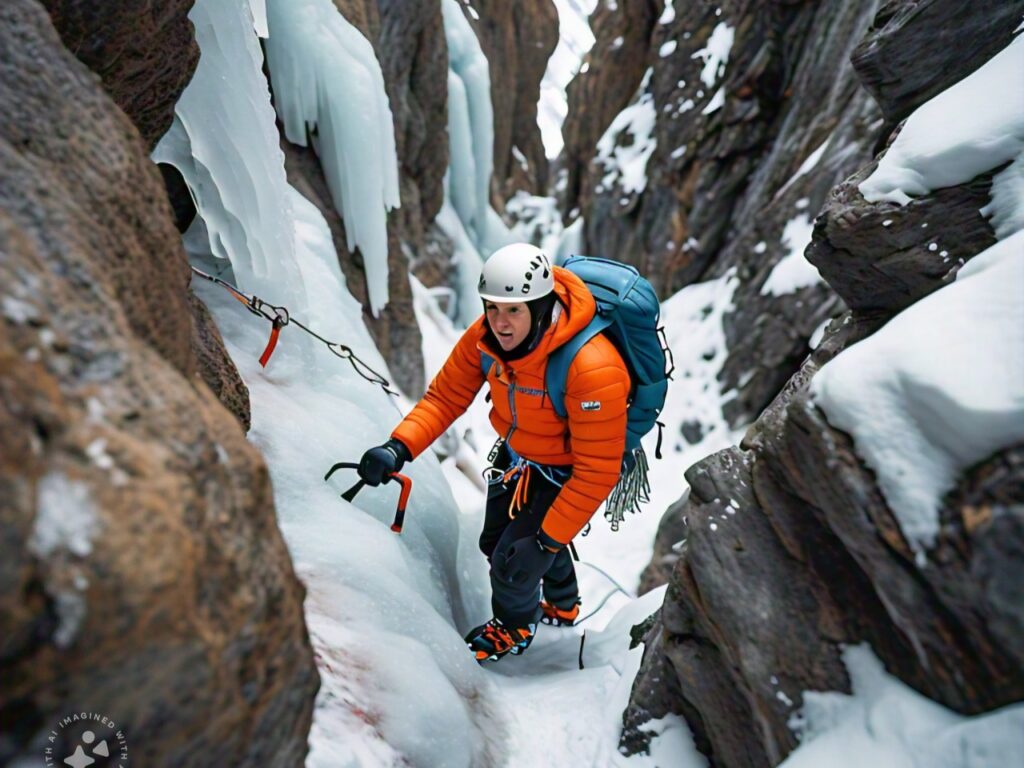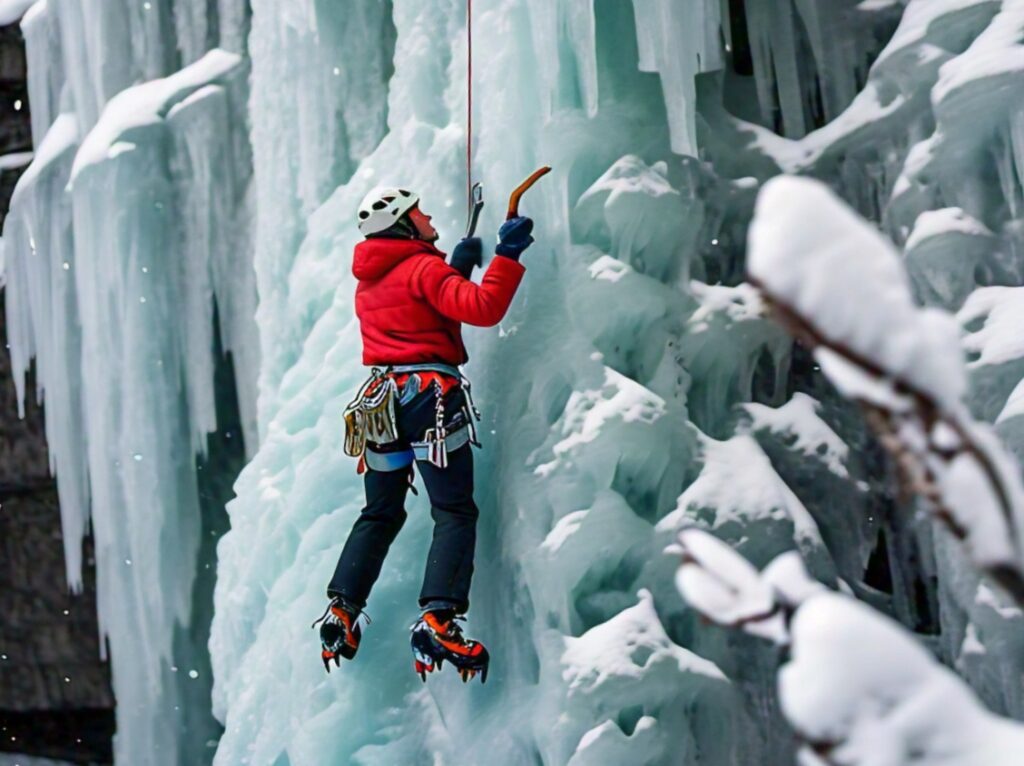
Ice Climbing: A Beginner’s Guide
Ice climbing is a thrilling sport where adventurers climb up frozen waterfalls, ice-covered rock faces, and icy slopes. It combines the excitement of mountaineering with the beauty of icy landscapes. Whether you are new to the sport or looking to improve your skills, this guide will provide you with all the information you need to get started. We’ll cover the essential equipment, basic techniques, safety tips, and some of the best locations for ice climbing around the world.
Key Takeaways
- Ice climbing is an adventurous sport involving climbing frozen waterfalls and icy slopes.
- Essential equipment includes ice axes, crampons, helmets, and ropes.
- Basic techniques like using ice axes and crampons are crucial for safety and efficiency.
- Always prioritize safety and be aware of weather conditions and avalanche risks.
- Popular ice climbing locations include the Alps, the Rockies, and the Himalayas.
What is Ice Climbing?
Ice climbing is a type of climbing that involves ascending ice formations. Climbers use special tools like ice axes and crampons to grip the ice and climb. Ice climbing can be done on natural ice formations, such as frozen waterfalls and glaciers, or on man-made ice walls.
“Ice climbing is like dancing on a vertical stage made of glass.”
Types of Ice Climbing
There are two main types of ice climbing:
- Waterfall Ice Climbing: This involves climbing frozen waterfalls. It is one of the most popular forms of ice climbing.
- Alpine Ice Climbing: This involves climbing ice that is found high in the mountains. It often includes mixed climbing, where climbers encounter both rock and ice.
Essential Equipment for Ice Climbing
To safely and effectively ice climb, you’ll need the right gear. Here’s a list of the essential equipment:
Ice Axes
Ice axes are one of the most important tools for ice climbing. They help climbers grip the ice and pull themselves up. There are two main types of ice axes:
- Technical Ice Axes: These are used for steep ice and mixed climbing. They have curved shafts and aggressive picks.
- Mountaineering Ice Axes: These are used for general mountaineering and have straighter shafts.
“A good ice axe is like an extension of your arm on the ice.”
Crampons
Crampons are metal spikes that attach to your boots. They provide traction on ice and snow. There are different types of crampons for different types of climbing:
- Step-in Crampons: These are used for technical ice climbing and have a secure fit.
- Strap-on Crampons: These can be used with any type of boot and are great for general mountaineering.
Helmets
A helmet is crucial for protecting your head from falling ice and other hazards. Make sure your helmet fits well and is comfortable to wear for long periods.
Ropes
Ropes are essential for safety in ice climbing. There are two main types of ropes used in climbing:
- Single Ropes: These are used for most types of climbing and are easy to handle.
- Double Ropes: These are used for longer climbs and offer more versatility.
Harnesses
A climbing harness is used to secure you to the rope. Make sure your harness fits well and is comfortable.
Other Gear
- Ice Screws: These are used to create anchor points in the ice.
- Carabiners: These are used to connect ropes and other gear.
- Belay Device: This is used to control the rope while climbing.
| Equipment | Purpose |
|---|---|
| Ice Axes | Grip and pull on the ice |
| Crampons | Provide traction on ice |
| Helmet | Protect head from falling ice |
| Ropes | Safety and climbing support |
| Harness | Secure climber to the rope |
| Ice Screws | Create anchor points in ice |
| Carabiners | Connect ropes and gear |
| Belay Device | Control the rope while climbing |
Basic Ice Climbing Techniques
To climb ice safely and efficiently, you’ll need to learn some basic techniques. Here are the most important ones:
Using Ice Axes
Ice axes are used to grip the ice and pull yourself up. Here’s how to use them:
- Placement: Swing the ice axe into the ice at chest height.
- Grip: Hold the ice axe firmly and pull yourself up.
- Movement: Move one ice axe at a time, maintaining three points of contact with the ice.
“Using ice axes is all about rhythm and balance.”

Using Crampons
Crampons provide traction on ice and help you climb. Here’s how to use them:
- Placement: Kick the front points of the crampons into the ice.
- Balance: Keep your weight centered over your feet.
- Movement: Move one foot at a time, maintaining three points of contact with the ice.
Climbing Techniques
There are different climbing techniques for different types of ice. Here are a few:
- French Technique: This involves using the side points of your crampons and is great for less steep ice.
- German Technique: This involves using the front points of your crampons and is used for steeper ice.
Belaying
Belaying is the technique used to manage the rope while climbing. Here’s how to do it:
- Belayer Position: The belayer stands below the climber and manages the rope.
- Climber Movement: The climber moves up the ice, and the belayer takes in the slack rope.
- Communication: The climber and belayer communicate to ensure safety.
Safety Tips for Ice Climbing
Safety is crucial in ice climbing. Here are some important tips to keep in mind:
Weather Conditions
Always check the weather conditions before you go ice climbing. Avoid climbing in bad weather, as it can make the ice unstable and increase the risk of avalanches.
Avalanche Safety
Avalanches are a major hazard in ice climbing. Here are some tips to stay safe:
- Check Avalanche Reports: Always check the local avalanche report before you go climbing.
- Avalanche Gear: Carry avalanche gear, including a beacon, probe, and shovel.
- Safety Training: Take an avalanche safety course to learn how to avoid and respond to avalanches.
“Safety is the most important skill in ice climbing.”
Ice Quality
The quality of the ice can vary greatly. Always check the ice before you climb to ensure it is solid and stable.
Climbing Partners
Never ice climb alone. Always climb with a partner and keep an eye on each other for signs of fatigue or hypothermia.
Best Locations for Ice Climbing
There are many great locations for ice climbing around the world. Here are some of the best:
The Alps
The Alps are home to some of the best ice climbing in the world. Popular locations include Chamonix in France and the Dolomites in Italy.
The Rockies
The Rocky Mountains in North America offer a wide range of ice climbing opportunities. Popular locations include Banff in Canada and Ouray in Colorado.
The Himalayas
The Himalayas offer some of the most challenging and rewarding ice climbing in the world. Popular locations include Nepal and India.
Other Locations
- Norway: Known for its stunning frozen waterfalls.
- Scotland: Offers a unique mix of rock and ice climbing.
- Japan: Home to some beautiful and challenging ice climbing routes.
| Topic | Key Points |
|---|---|
| What is Ice Climbing? | Climbing frozen waterfalls and icy slopes |
| Essential Equipment | Ice axes, crampons, helmets, ropes, harnesses |
| Basic Techniques | Using ice axes, crampons, and belaying |
| Safety Tips | Check weather, avalanche safety, ice quality, partners |
| Best Locations | Alps, Rockies, Himalayas, Norway, Scotland, Japan |
Conclusion
Ice climbing is an exciting and challenging sport that offers a unique way to experience the beauty of winter landscapes. By understanding the essential equipment, learning basic techniques, prioritizing safety, and exploring the best locations, you can enjoy this thrilling activity safely and effectively. Always remember to climb with a partner, check weather conditions, and be aware of avalanche risks. Happy climbing!
What is icefall climbing?
Icefall climbing is the sport of climbing frozen waterfalls and ice formations.
How do people climb ice?
People climb ice using specialized equipment like ice axes, crampons, ropes, and harnesses.
What is ice climbing description?
Ice climbing is a sport where climbers ascend frozen waterfalls, ice-covered rock faces, and icy slopes using tools like ice axes and crampons.
What is ice climbing description?
Ice climbing is a sport where climbers ascend frozen waterfalls, ice-covered rock faces, and icy slopes using tools like ice axes and crampons.